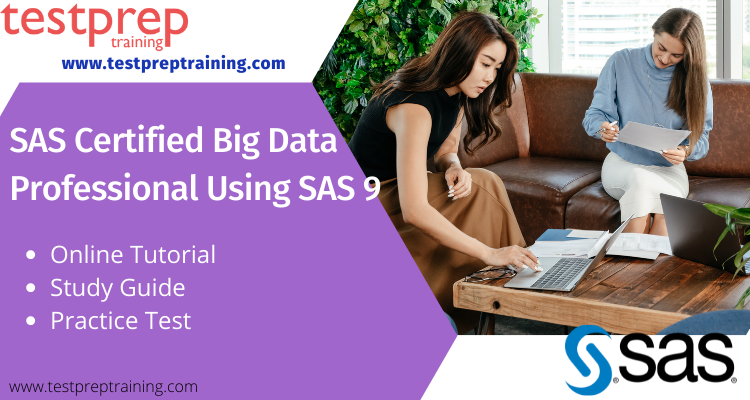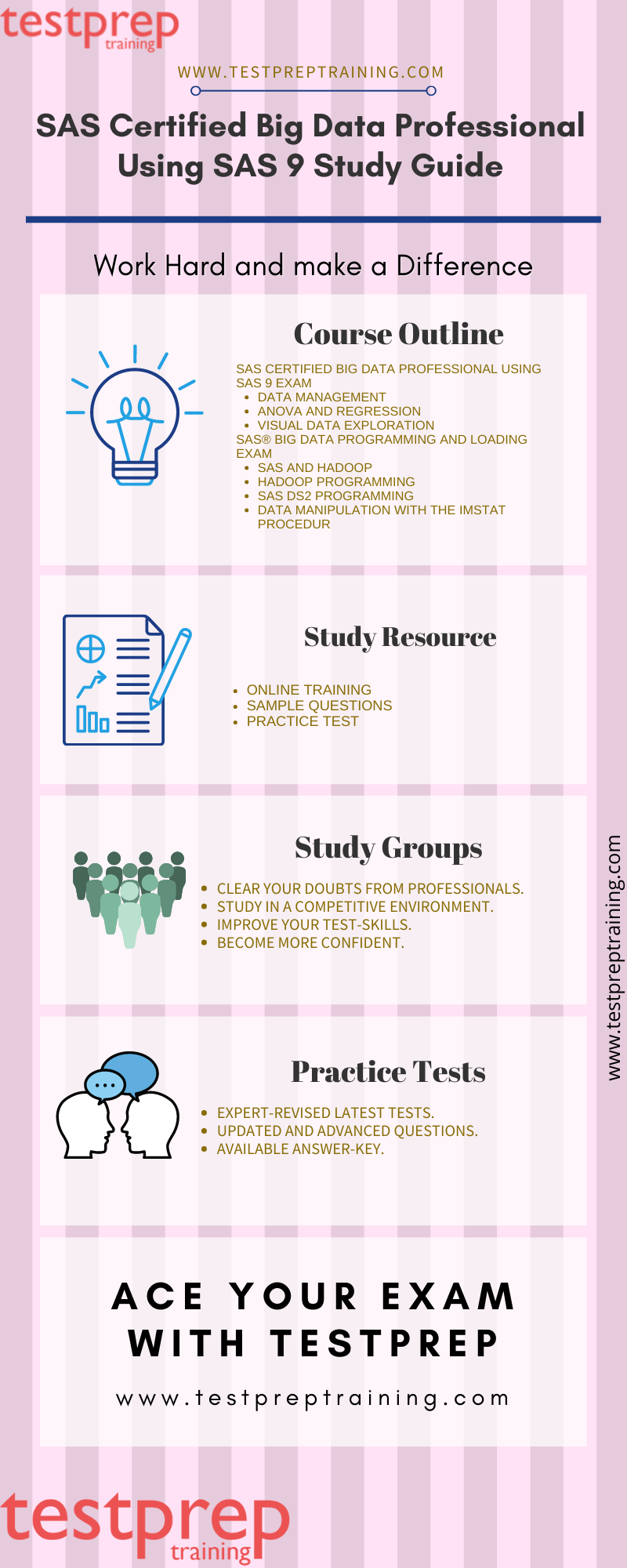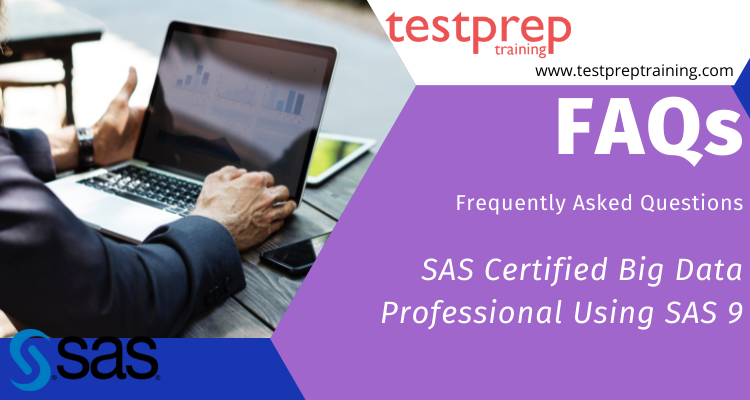SAS Certified Big Data Professional Using SAS 9

The SAS Certified Big Data Professional Using SAS 9 exam is one of the main certifications offered by the SAS Global Certification program. This certification is specially intended for individuals who want to prove their ability to use open source and SAS Data Management tools to prepare big data for statistical analysis. Moreover, candidates who earn this credential will be required to pass two exams, namely:
- SAS Big Data Preparation, Statistics, and Visual Exploration
- SAS Big Data Programming and Loading
Therefore, we have prepared the study guide for the SAS Certified Big Data Professional Using SAS 9 exam to help you ace your exam. So, follow us for the more and latest exam updates.
Exam Details
SAS Big Data Preparation, Statistics, and Visual Exploration Exam details:
| Exam Name | SAS Big Data Preparation, Statistics, and Visual Exploration Exam |
| Exam ID | A00-220 |
| Number of Questions | 55-60 |
| Exam Format | multiple-choice, short answer, and interactive questions |
| Duration | 110 minutes |
| Passing Scores | 67% |
Prerequisites:
Hands-on experience with the following analytical tools:
- SAS/STAT
- SAS Visual Analytics
- Lastly, SAS DataFlux Data Management Studio.
SAS Big Data Programming and Loading Exam details:
| Exam Name | SAS® Big Data Programming and Loading Exam |
| Exam ID | A00-221 |
| Number of Questions | 60-65 |
| Exam Format | multiple-choice, short answer, and interactive questions |
| Duration | 105 minutes |
| Passing Scores | 68% |
Prerequisites:
Hands-on experience with the following analytical tools:
- SAS Base and DS2 programming.
- Hadoop, Apache Pig, Apache Hive.
- SAS In-Memory Statistics.
Learning Outcomes
- Recognize and overcome big data challenges.
- Implement critical SAS programming techniques.
- Access, transform and manipulate data.
- Improve data quality for reporting and analytics.
- Apply fundamental statistical techniques.
- Work with SAS, Hadoop and Hive.
- Explore and visualize data.
Schedule your Exam
- This exam is administered by SAS and Pearson VUE. The candidate must register for the exam at Pearson VUE.
- The exam ID i.e. A00-908 will be required while registering. The exam fee is $180 USD in India and most other countries. Click here to register for the exam.
Before taking the Exam
- Candidates are required to provide two forms of identification to the testing center, including one photo identification such as a driver’s license or a valid passport. Both forms must display the candidate’s signature.
- Candidates should plan to arrive 15 minutes before their scheduled exam time. However, candidates arriving more than 15 minutes late are not guaranteed exam availability or a refund.
- Candidates are not permitted to bring reference materials of any kind into the testing center.
- Please leave any backpacks, laptops, briefcases and other personal items at home.
After the Exam
- You will immediately receive a pass/fail score upon completion of your exam attempt at your testing facility.
- If you pass your exam and meet all requirements for this credential, you will receive an e-mail from SAS with instructions providing access to your certificate and logo through SAS Certification Manager.
Retake your Exam
- Candidates may attempt each certification exam up to five times in a 12-month period, waiting for a minimum of 14 days between attempts. Exam charges are incurred for each exam attempt. Exams that do not comply with this retake policy will be considered invalid and will not be eligible for a refund and/or a certification credential.
- Once a passing score is achieved on a specific exam, no further attempts are allowed on that exam.
For More: Check SAS Certified Big Data Professional Using SAS 9 FAQs
Course Outline
1. SAS Big Data Preparation, Statistics, and Visual Exploration Exam
- Data Management – 50%
- Navigate within the Data Management Studio Interface
- Create, design and be able to explore data explorations and interpret results
- Define and create data collections from exploration results
- Create and explore a data profile
- Design data standardization schemes
- Create Data Jobs
- Apply a Standardization definition and scheme
- Apply Parsing definitions
- Compare and contrast the differences between identification analysis and right fielding nodes
- Apply the Gender Analysis node to determine gender
- Create an Entity Resolution Job
- Define and create business rules
- Describe the organization, structure and basic navigation of the QKB
- Be able to articulate when to use the various components of the QKB
- Define the processing steps and components used in the different definition types
- ANOVA and Regression – 30%
- Verify the assumptions of ANOVA
- Analyze differences between population means using the GLM and TTEST procedures
- Perform ANOVA post hoc test to evaluate treatment affect
- Detect and analyze interactions between factors
- Fit a multiple linear regression model using the REG and GLM procedures
- Analyze the output of the REG, PLM, and GLM procedures for multiple linear regression models
- Use the REG or GLMSELECT procedure to perform model selection
- Assess the validity of a given regression model through the use of diagnostic and residual analysis
- Perform logistic regression with the LOGISTIC procedure
- Optimize model performance through input selection
- Interpret the output of the LOGISTIC procedure
- Visual Data Exploration – 20%
- Examine, modify, and create data items
- Select and work with data sources
- Create, modify, and interpret automatic chart visualizations in Visual Analytics Explorer
- Create, modify, and interpret graph and table visualizations in Visual Analytics Explorer
- Enhance visualizations with analytics within Visual Analytics Explorer
- Interact with visualizations and explorations within Visual Analytics Explorer
2. SAS® Big Data Programming and Loading Exam
- SAS and Hadoop – 30%
- Describe the baseline requirements for interacting with Hadoop
- Use the HADOOP procedure and the Hadoop FILENAME statement to interact with Hadoop from a SAS session
- Query and manage Hive tables stored in Hadoop using explicit SQL pass-through
- Work with Hadoop files using the SAS/ACCESS LIBNAME statement
- SAS DS2 Programming – 30%
- Write DS2 programs
- Read data using DS2
- Work with variables, arrays, and ANSI SQL data types
- Use expressions and functions in DS2 programs
- Work with Methods, Packages, and Threads
- Hadoop Programming – 15%
- Describe the Hadoop architecture
- Manipulate and load data files using command line tools
- Write Hive programs to create, join, and query data tables
- Write Pig programs to perform ETL tasks and to analyze large data sets
- Data manipulation with the IMSTAT procedure – 25%
- Execute IMSTAT procedures
- Perform actions required to produce graphs with PROC IMSTAT
- Manipulate In-Memory Data
- Use High-Performance procedures with the SAS LASR Analytic Server
SAS Certified Big Data Professional Using SAS 9 Study Guide
The SAS Certified Big Data Professional Using SAS 9 exam requires utmost dedication and concentration. The most important part while preparing for any exam is to choose the right sources for study material. The internet is filled with diverse resources but one should be very careful while choosing the best for yourself. Moreover, one should look for quality content rather than quantity. Therefore, we’ve provided our users with the simplest and expert-revised study guide in order that our users don’t lack in any sphere and ace the examination with flying colors.

1. Getting Familiar with the Course Outline
SAS Certified Big Data Professional Using SAS 9 Exam
- Data Management
- ANOVA and Regression
- Visual Data Exploration
SAS® Big Data Programming and Loading Exam
- SAS and Hadoop
- Hadoop Programming
- SAS DS2 Programming
- Data manipulation with the IMSTAT procedure
2. Study Resources
- Online Training: Below mentioned are some useful online courses for SAS SAS Big Data Preparation, Statistics, and Visual Exploration Exam and SAS® Big Data Programming and Loading Exam that will help you in your preparation.
- SAS Academy for Data Science: Data Curation Professional
- Statistics 1: Introduction to ANOVA, Regression, and Logistic Regression
- SAS Visual Analytics: Fast Track
- DataFlux® Data Management Studio: Fast Track
- DataFlux® Data Management Studio: Understanding the Quality Knowledge Base
- SAS Academy for Data Science: Big Data
- DataFlux® Data Management Studio: Creating a New Data Type in the Quality Knowledge Base
- Introduction to SAS and Hadoop
- Getting Started with SAS In-Memory Statistics
- Sample Questions: Download the Sample Questions for SAS Big Data Preparation, Statistics, and Visual Exploration Exam and SAS® Big Data Programming and Loading Exam from the official site of SAS to get a better understanding for every topic.
- Practice Exam: Taking practice exam from the SAS Big Data Preparation, Statistics, and Visual Exploration Exam and SAS® Big Data Programming and Loading Exam is the best way to ensure that you’re ready for the exam.
3. Join Online Study Groups
Joining online study groups is the most appropriate way to improve your examination skills and understand of things in a better way. Since study groups provide you with a platform to debate and clear your doubts in the absolute best way with the assistance of experts. Moreover, joining study groups helps you to keep yourself updated with any recent modifications or any changes within the examination.
4. Practice Test
While preparing for any examination the most important step is to take SAS Certified Big Data Professional Using SAS 9 practice tests. These tests do not only help you to check your preparation level, and build your confidence and time management but also help you to get familiar with different types of questions that are frequently asked in the examination. Moreover, the SAS Certified Big Data Professional Using SAS 9 practice test consists of questions from basic to advanced levels in a systematic manner.


